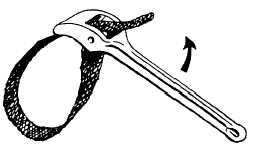purpose and should be used only on the objects they
are designed for. When you use a hand tool for other
purposes, you usually damage both the tool and the
object it is used on. Use screwdrivers to drive and
remove screws. Do not use them to scrape paint, as a
pry bar or chisel, and certainly never use them to test
an electrical circuit.
STANDARD SCREW
DRIVER
Three main parts make up the construction of the
standard screwdriver (fig. 2-1, view A), the handle,
the shank, and the end. The end (called the blade) fits
into the screw slot. When using a screwdriver, select
the proper size blade for the job intended. A blade too
large or too small causes the screwdriver blade and
the screwhead to become damaged. At least 75 per-
cent of the screw slot should be filled by the blade for
proper fit.
PHILLIPS HEAD
SCREWDRIVER
A Phillips head screwdriver (fig. 2-1, view B)
differs in construction from a standard screwdriver
only in that the tip is shaped to fit the special cavity in
the Phillips screwhead. A standard screwdriver must
never be used in a Phillips screwhead as damage will
occur to it. The Phillips cavity should be filled com-
pletely by the selected driver for proper fit.
HAMMER
The hammer (fig. 2-1. view G) most used by the
ABF is the ball peen. The ball peen hammer is used
for working metals, such as chiseling rivets and shear-
ing metal.
COMBINATION PLIERS
Combination pliers (fig. 2-1, view C) are manu-
factured with straight serrated jaws for gripping ob-
jects. The pivots, with which the jaws are attached, are
adjustable to fit different size objects. Pliers should
not be used to grasp the shanks of screwdrivers to gain
greater twisting force.
DIAGONAL PLIERS
Diagonal pliers (fig. 2-1, view D) are used only
for cutting small material such as wire or cotter pins.
They are designed specifically for cutting. They
should NOT be used for grasping objects such as nuts
and bolts.
ADJUSTABLE WRENCHES
An adjustable wrench (fig. 2-1, view E) is not
intended to replace an open-end wrench, but it is
useful in working in restricted areas. In addition, it
can be adjusted to fit odd-sized nuts or bolts. This
wrench is often called a knuckle buster because me-
chanics frequently suffer the consequences of using it
improperly.
PIPE WRENCHES
A pipe wrench (fig. 2-1, view F) is primarily used
for rotating round stock and/or various pipes and pip-
ing. The most common pipe wrench is the Stillson. It
has two jaws that have serrated teeth to provide a
gripping ability. The larger jaw is a fixed jaw. The
smaller jaw is adjustable and the weaker of the two
jaws. Whenever a Stillson wrench is used, it should be
applied in such a manner that the fixed jaw provides
the twisting force. These wrenches also come in vary-
ing lengths, which makes the jaw sizes vary. A Still-
son wrench should never be used on machined
surfaces, as the teeth tend to mar or otherwise ruin the
metal.
The strap wrench (fig. 2-2) should be used instead
of a Stillson to eliminate damage to soft metals. The
strap wrench employs a heavy nylon strap. One end is
attached to the wrench handle. while the other end is
free to pass around the object to be rotated, and then
back through the locking device provided on the
wrench handle.
SPANNER WRENCHES
Many special nuts are made with notches cut into
their outer edge. For these nuts a hook spanner
Figure 2-2.—Strap wrench.
2-2


